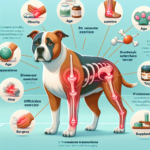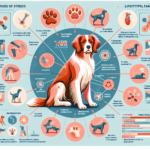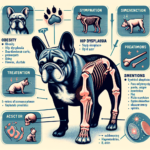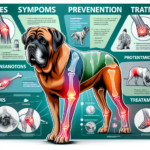Bluetick Coonhound Joint Pain: Causes, Symptoms, Prevention, and Treatment
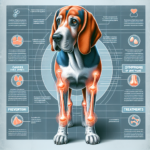
Introduction
The Bluetick Coonhound is a breed known for its striking blue-ticked coat, keen sense of smell, and exceptional hunting abilities. Originating in the United States, this breed was developed from various hound breeds, including the French Staghound and the English Foxhound, to create a dog that excels in tracking and treeing raccoons. Bluetick Coonhounds are characterized by their muscular build, long ears, and expressive eyes, making them not only excellent working dogs but also affectionate family pets.
Like many breeds, Bluetick Coonhounds are prone to certain health issues. Among these, joint pain is a significant concern that can affect their quality of life. Joint pain in dogs can stem from various causes, including genetic predispositions, age-related wear and tear, and the physical demands of their active lifestyle. Understanding the causes, symptoms, prevention, and treatment of joint pain in Bluetick Coonhounds is crucial for ensuring their long-term health and well-being.
Joint health is particularly important for Bluetick Coonhounds due to their active nature and working background. These dogs are often involved in strenuous activities such as hunting, which can put additional stress on their joints. Maintaining joint health is essential to keep them agile, comfortable, and able to perform their tasks effectively.
Breed-Specific Joint Pain Risks
Genetic Predisposition
Bluetick Coonhounds, like many purebred dogs, have a genetic predisposition to certain joint-related issues. Hip dysplasia, a condition where the hip joint does not fit properly into the hip socket, is relatively common in this breed. This can lead to arthritis and significant pain over time. Elbow dysplasia, another genetic condition, affects the elbow joints and can cause similar issues. Both conditions are hereditary and can be exacerbated by environmental factors.
Age-Related Risks
As Bluetick Coonhounds age, they become more susceptible to joint pain and related conditions. Arthritis, a degenerative joint disease, is particularly common in older dogs. The breed’s average lifespan is around 11-12 years, and joint issues often become more pronounced as they reach their senior years. Owners should be vigilant about monitoring their dog’s joint health as they age, especially after the age of seven.
Activity Level and Joint Stress
Bluetick Coonhounds are known for their high energy levels and love for physical activity. Whether they are hunting, running, or playing, their joints are constantly under stress. While regular exercise is essential for their overall health, excessive or high-impact activities can contribute to joint wear and tear. Owners should balance their dog’s need for exercise with the potential risk of joint stress.
Common Symptoms of Joint Pain in Bluetick Coonhounds
General Symptoms
Joint pain in Bluetick Coonhounds can manifest in various ways. Common symptoms include:
- Limping: A noticeable limp or favoring one leg over another.
- Stiffness: Difficulty getting up or lying down, especially after rest.
- Reluctance to Move: Hesitation or refusal to engage in physical activities they once enjoyed.
- Swelling: Visible swelling around the joints.
- Behavioral Changes: Increased irritability or signs of discomfort when touched.
Breed-Specific Symptoms
In Bluetick Coonhounds, joint pain may also present with breed-specific symptoms such as:
- Decreased Endurance: Reduced stamina during hunting or long walks.
- Altered Gait: A noticeable change in their walking or running pattern.
- Vocalization: Whining or yelping when moving or being touched.
When to Consult a Vet
If you notice any of the above symptoms in your Bluetick Coonhound, it is essential to consult a veterinarian. Early intervention can prevent further deterioration and improve your dog’s quality of life. Seek veterinary advice if:
- Your dog shows persistent limping or stiffness.
- There is visible swelling or heat around the joints.
- Your dog is reluctant to move or shows signs of pain when touched.
- There are noticeable changes in behavior or activity levels.
Preventive Measures for Joint Health
Exercise Recommendations
Regular exercise is crucial for maintaining joint health in Bluetick Coonhounds. However, it is essential to choose the right types of activities. Low-impact exercises such as swimming and walking on soft surfaces can help keep their joints healthy without causing excessive stress. Avoid activities that involve jumping or sudden changes in direction, as these can exacerbate joint issues.
Dietary Suggestions
A balanced diet rich in essential nutrients can support joint health. Consider incorporating the following into your Bluetick Coonhound’s diet:
- Glucosamine and Chondroitin: These supplements can help maintain cartilage health and reduce joint pain.
- Omega-3 Fatty Acids: Found in fish oil, these can reduce inflammation and support overall joint health.
- Antioxidants: Vitamins C and E can help protect joint tissues from damage.
Weight Management
Maintaining a healthy weight is crucial for reducing joint stress. Excess weight can put additional pressure on the joints, exacerbating pain and discomfort. Monitor your dog’s weight regularly and adjust their diet and exercise routine as needed to keep them at an optimal weight.
Early Screening and Monitoring
Early detection of joint issues can significantly improve outcomes. Regular veterinary check-ups, including screenings for hip and elbow dysplasia, can help catch problems early. Your vet may recommend X-rays or other diagnostic tests to assess joint health and provide appropriate interventions.
Treatment Options for Joint Pain
Non-Surgical Treatments
For many Bluetick Coonhounds, non-surgical treatments can effectively manage joint pain. These may include:
- Medications: Nonsteroidal anti-inflammatory drugs (NSAIDs) can reduce pain and inflammation. Your vet may also prescribe pain relievers or joint supplements.
- Physical Therapy: Exercises and therapies designed to strengthen muscles and improve joint function.
- Lifestyle Adjustments: Modifying your dog’s activity levels and providing a comfortable living environment.
Surgical Options
In severe cases, surgical intervention may be necessary. Common surgical options for joint pain in Bluetick Coonhounds include:
- Hip Replacement: Replacing the damaged hip joint with an artificial one.
- Arthroscopy: A minimally invasive procedure to remove damaged tissue or repair joints.
- Joint Fusion: Fusing the bones in a joint to reduce pain and improve stability.
Alternative Therapies
Alternative treatments can complement traditional therapies and provide additional relief. Consider the following options:
- Acupuncture: This ancient practice can help reduce pain and improve joint function.
- Hydrotherapy: Water-based exercises that reduce joint stress while improving strength and mobility.
- Massage: Therapeutic massage can alleviate muscle tension and improve circulation.
Lifestyle and Management Tips
Daily Care Routine
A consistent daily care routine can help manage joint pain in Bluetick Coonhounds. Consider the following:
- Regular Exercise: Engage in low-impact activities like walking or swimming.
- Balanced Diet: Provide a diet rich in joint-supporting nutrients.
- Weight Monitoring: Keep track of your dog’s weight and adjust their diet as needed.
- Joint Supplements: Incorporate glucosamine, chondroitin, and omega-3 fatty acids into their diet.
Modifying the Home Environment
Making your home more comfortable for a dog with joint pain can significantly improve their quality of life. Consider the following modifications:
- Ramps: Use ramps instead of stairs to reduce joint strain.
- Orthopedic Beds: Provide a supportive bed to alleviate pressure on the joints.
- Non-Slip Flooring: Ensure your home has non-slip surfaces to prevent falls.
Long-Term Management
Long-term management of joint pain involves ongoing care and monitoring. Regular veterinary check-ups, consistent exercise, and a balanced diet are essential. Additionally, consider incorporating alternative therapies and making necessary lifestyle adjustments to keep your Bluetick Coonhound comfortable and active.
FAQs About Bluetick Coonhounds and Joint Pain
What are the early signs of joint pain in Bluetick Coonhounds?
Early signs of joint pain include limping, stiffness, reluctance to move, and behavioral changes such as increased irritability or vocalization when touched.
Can joint pain in Bluetick Coonhounds be prevented?
While genetic predispositions cannot be entirely prevented, maintaining a healthy weight, providing a balanced diet, and engaging in low-impact exercises can help reduce the risk of joint pain.
Are there specific diets that can help with joint health?
Yes, diets rich in glucosamine, chondroitin, omega-3 fatty acids, and antioxidants can support joint health. Consult your vet for specific dietary recommendations.
When should I consult a vet about my dog’s joint pain?
If your dog shows persistent limping, stiffness, reluctance to move, or any signs of pain, it is essential to consult a veterinarian for a proper diagnosis and treatment plan.
What are the best exercises for a Bluetick Coonhound with joint pain?
Low-impact exercises such as swimming and walking on soft surfaces are ideal for dogs with joint pain. Avoid high-impact activities that can exacerbate joint stress.
Conclusion
Joint pain is a common issue in Bluetick Coonhounds, but with proper care and attention, it can be managed effectively. Understanding the causes, symptoms, prevention, and treatment options is crucial for maintaining your dog’s joint health. Regular veterinary check-ups, a balanced diet, appropriate exercise, and early intervention can significantly improve your Bluetick Coonhound’s quality of life. By taking proactive measures and consulting your veterinarian regularly, you can ensure that your dog remains active, comfortable, and happy for years to come.

